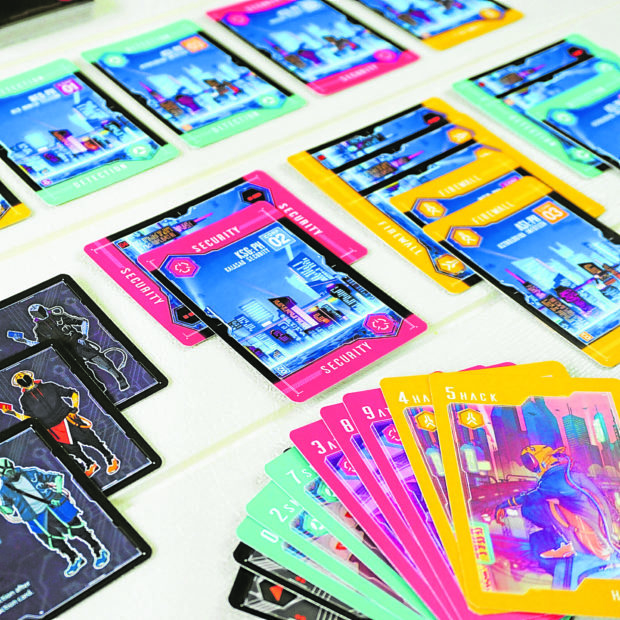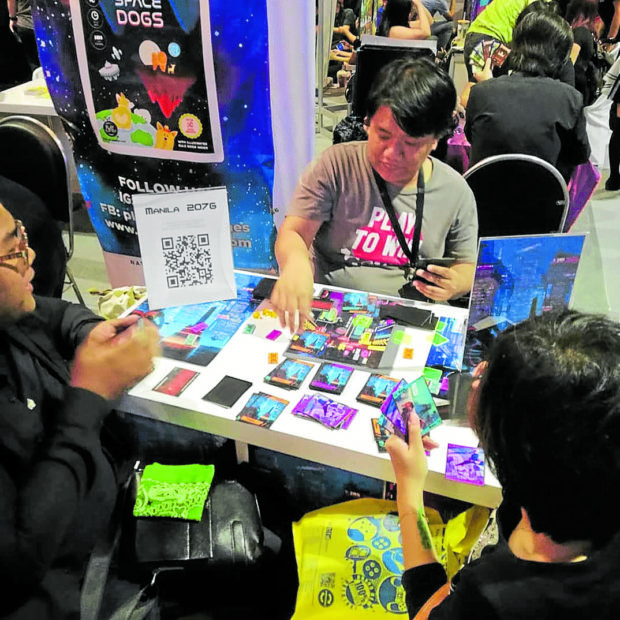In the future, Megacorps own and run the lives of billions in a neo-punk version of Metro Manila.
Card game creator and developer Fred Tay endeavored to capture the milieu of this imagined, dystopic future in his tabletop card game Manila 2076, where players have been hired by a mysterious client to steal data from one of the evil megacorporations.
These Megacorps have basically taken control of all aspects of people’s lives and, of course, the masses are more than happy to obey their corporate masters as long as they are fed and consuming happily.
If it all sounds a bit too close to home, then you’re already feeling the menacing vibe of cyberpunk as a futurist genre where technologies directly mirror our own, yet with a projected future that’s eerily as plausible as Boston Dynamic’s robot dogs.
“It’s not fun to live in a cyberpunk society, so let’s all do our best in creating an awesome version of the future,” said Tay, who graduated with a degree in management engineering and eventually took over their family business. His love for both analog and video games never wavered, though, and he continued to make games during his downtime, after work was done.
Tay got hooked on tabletop games early on, when he played Magic: The Gathering in elementary school.
“But back then, my friends and I couldn’t afford to buy the cards,” he said. “So, instead, I got a Xeroxed copy of the rulebook, looked at the cards that other players had, and tried to create my own version of the game using index cards and had a blast playing it with my classmates!”
Tay and his friends even designed a simple home-brew randomizer system using a calculator that they played during boring classes.
“Suffice to say, we did not learn much about Chinese history, but we did have some epic mech fights!”
Ninja Cats
Tay came out with his first card game, Ninja Cats, before he mustered enough courage to put his love of cyberpunk on paper.
In Ninja Cats, kleptomaniac ninja cats steal stuff and get points. Tay looks back on the game with a kind of self-awareness. “Although very cute, it was absolutely terrible to play!”
Inspired by the card games M:TG and Netrunner, a healthy dose of the Deus Ex video game franchise, and motivated by a self-development workshop in Singapore, Tay’s research, and many iterations and play tests on the cyberpunk genre finally came to fruition in 2019.
Players in Manila 2076 are data cowboys trying to sneak, hack or attack their way into corporate HQ to obtain valuable data cards. However, some of the data cards are being tracked by the enemy and can be corrupted, leading the player carrying them to experience malfunctions.

I had the chance to do two play-throughs, with a copy of the game provided by the designer. Made for two to four players, each play session can last from 15 to 20 minutes.
Right off the bat, I liked how the cards were slightly smaller than your usual playing cards. They’re a great design point that makes them easy to shuffle and handle.
I really loved how compact the whole package was, which included the cards, flyers for instructions and sample gameplay, and a postcard of the credits and art. Some names of the corporations like Neo-Manila Telecom, Kalasag Ph Security, and Astrologika Infotech are also great touches of localization.
The art by illustrators Borg Sinaban and Kit Stark bring the future Pinoy dystopia to apt, atmospheric life, especially with nods to classic cyberpunk entertainment like “Tron,” “Bladerunner,” “The Matrix Trilogy,” “Ghost in the Shell” and “Akira.”
The art also evokes a plausible and yet very cyberpunk aesthetic of a future mapped by the works of Philip K. Dick, William Gibson, and local creators like Paolo Chikiamco (“Mythspace”) and TJ Dimacali (“Skygypsies”).
Brute force or stealth
The homage to Netrunner is apparent and a good takeoff point for those already familiar with card games. The choice to brute force or stealth it with “hidden bids” and bluffing to accomplish your mission is a great factor for enjoyment.
The stealth/assault icon marker is also a nice extra touch of physicality to the package. Most of all, the deck’s ability to bite back (the Megacorps making their influence known) is a nice touch of balance, bringing to fore the consequences of screwing up the attacks.
“I wanted a way for players to either use brute force or to use stealth to accomplish their goals,” said Tay.

“I also knew I wanted to transport my players into a cyberpunk world. They should feel like black-ops hackers on a mission to breach the advanced defenses of data centers to steal valuable intel.”
On both my play-throughs, however, despite having gone through the attached instructions several times, I found that the mechanics weren’t easy to get into just from reading the text. But after watching the YouTube sample play video and instructional, I found I got a better grasp of the rules and gameplay.
On both play sessions, both lasting around 20 minutes, I found that the length of the attack and defense cycle tended to be quite tedious. By the second play-through, the lack of motivation made another go-around unappealing to me. Perhaps this is due to my lack of experience in card games? Still, this is indicative of the mechanics being not very kind to beginners, a high barrier to entry that should be considered for future versions.
I also found that the range of the character art lacking. I do appreciate a variety of art to look at, even if I suck at playing. But there weren’t that many differences, especially with the helmets on the character cards which, now that I think about it, remind me of our delivery riders in Angkas or Lalamove. A variety of faces (only the Infosec card has a face) instead of helmeted people, would’ve been a huge improvement.
Overall, I did feel how the spirit of competing against your fellow player as a data cowboy and also against the deck trying to chase you down for the secret information you stole was pretty central to the game experience. Still, I did not feel like it was that exciting of a process, albeit the idea of sticking it to the powers that be of the future was pretty much the allure for me when I got the game package.
Potential for collaboration
Despite all that, I believe that Manila 2076 is a very cool world with plenty of potential for collaboration and fine-tuning. An imagined future where other creators can join Tay and take a romp through the data centers and crypto corridors that will not only improve the next version of the game, but also empower local storytellers who want to explore this genre better.
“It’s amazing how the game mechanics can weave intricate stories much like a novel,” said Tay.

“I aspired to create a game that can transport my players into these fantastic imaginary worlds and to create memorable stories. My next goal is to create a series of card games that are all set in the Manila 2076 world, where each game shows a different aspect of life in this cyberpunk world.”
Manila 2076, the card game is available to order from its Facebook page (www.facebook.com/manila2076/) or on Shopee.











































